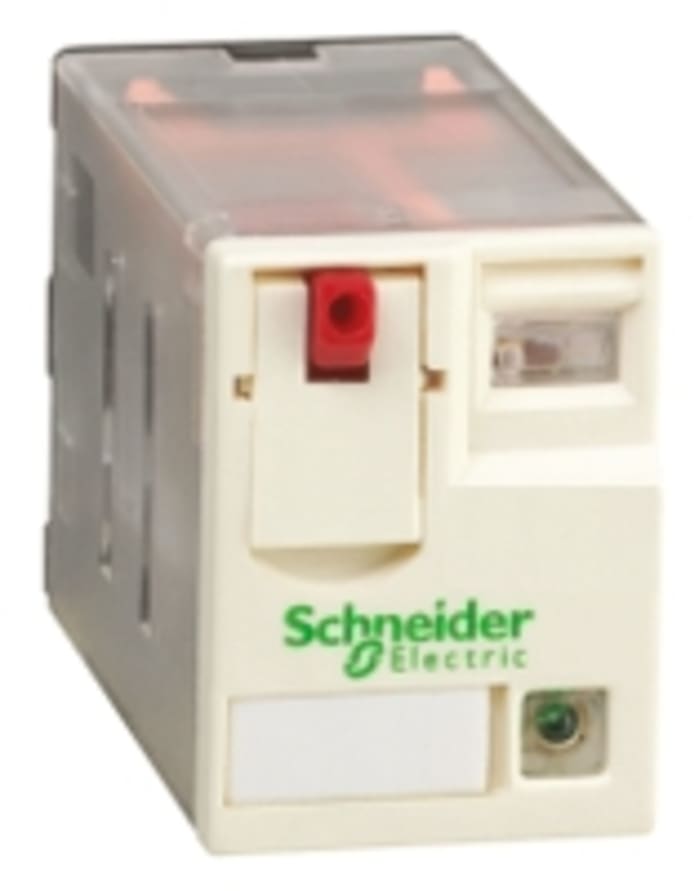Technical Document
Specifications
Brand
Schneider ElectricCoil Voltage
24V ac
Contact Configuration
DPDT
Mounting Type
Plug In
Switching Current
12A
Number of Poles
2
Latching
No
Terminal Type
Plug In
Maximum Switching Voltage AC
250V
Length
21mm
Coil Resistance
180Ω
Coil Power
1.2W
Minimum Operating Temperature
-40°C
Standards Met
CE, CSA, EN/IEC, GOST, Lloyd's, REACH, RoHS Compliant, UL
Maximum Operating Temperature
+55°C
Depth
40mm
Life
100000 cycles
Better World Verification
Green Premium
Height
27mm
Better World Product (Find out more)
Yes
Contact Material
Silver Alloy
Maximum Switching Power DC
336 W
Maximum Switching Power AC
3 kVA
Country of Origin
China
Product details
Schneider Electric Miniature Relays - RXM Series
Introducing Schneider Electrics compact RXM miniature relays with LED. They are often used to increase the functions in electrical enclosures, predominantly for industrial applications (machine/building equipment and HVAC). These relays can be referred to as an electromechanical relay or an industrial switch.
Features & Benefits
- Easy to install and programme, integration into current devices is also easy and they have the functionality to be adapted for all voltages
- Simple to use with no adjustments required for standard applications
- Each miniature relay from the RXM range features a test button and mechanical indicator of the relay status
- If you are looking for a base for assembly on to a DIN rail or with screws these need to be ordered separately
- Robust and hard-wearing
- Compact in design and in size
What is a non-latching relay and how do they work?
A relay is an electrical switch that is operated by electrical pulses, their primary function is to open and close a circuit. When power passes through a circuit, a relay switches position (usually from NC to NO) using an internal coil which generates a magnetic force. This force then holds the relay in a NO position, when the current is switched off the relay returns to the NC position. This function is what makes these non-latching relays perfect for push-button applications such as keyboards and micro-controller input buttons.

AED 45.57
AED 45.57 Each (ex VAT)
AED 47.85
AED 47.85 Each (inc. VAT)
1
AED 45.57
AED 45.57 Each (ex VAT)
AED 47.85
AED 47.85 Each (inc. VAT)
1
Stock information temporarily unavailable.
Please check again later.
| quantity | Unit price |
|---|---|
| 1 - 4 | AED 45.57 |
| 5 - 9 | AED 44.26 |
| 10+ | AED 43.16 |

Technical Document
Specifications
Brand
Schneider ElectricCoil Voltage
24V ac
Contact Configuration
DPDT
Mounting Type
Plug In
Switching Current
12A
Number of Poles
2
Latching
No
Terminal Type
Plug In
Maximum Switching Voltage AC
250V
Length
21mm
Coil Resistance
180Ω
Coil Power
1.2W
Minimum Operating Temperature
-40°C
Standards Met
CE, CSA, EN/IEC, GOST, Lloyd's, REACH, RoHS Compliant, UL
Maximum Operating Temperature
+55°C
Depth
40mm
Life
100000 cycles
Better World Verification
Green Premium
Height
27mm
Better World Product (Find out more)
Yes
Contact Material
Silver Alloy
Maximum Switching Power DC
336 W
Maximum Switching Power AC
3 kVA
Country of Origin
China
Product details
Schneider Electric Miniature Relays - RXM Series
Introducing Schneider Electrics compact RXM miniature relays with LED. They are often used to increase the functions in electrical enclosures, predominantly for industrial applications (machine/building equipment and HVAC). These relays can be referred to as an electromechanical relay or an industrial switch.
Features & Benefits
- Easy to install and programme, integration into current devices is also easy and they have the functionality to be adapted for all voltages
- Simple to use with no adjustments required for standard applications
- Each miniature relay from the RXM range features a test button and mechanical indicator of the relay status
- If you are looking for a base for assembly on to a DIN rail or with screws these need to be ordered separately
- Robust and hard-wearing
- Compact in design and in size
What is a non-latching relay and how do they work?
A relay is an electrical switch that is operated by electrical pulses, their primary function is to open and close a circuit. When power passes through a circuit, a relay switches position (usually from NC to NO) using an internal coil which generates a magnetic force. This force then holds the relay in a NO position, when the current is switched off the relay returns to the NC position. This function is what makes these non-latching relays perfect for push-button applications such as keyboards and micro-controller input buttons.



